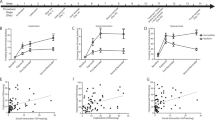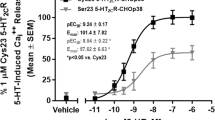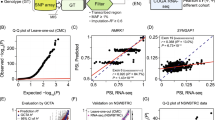Abstract
Changes in serotonin2C receptor (5-HTR2c) editing, splicing and density were found in conditions such as depression and suicide, but mechanisms explaining the changes in 5-HTR2c function are unknown. Thus, mice expressing only the fully edited VGV isoform of 5-HTR2c, in which clinically relevant behavioral changes are associated with alterations in splicing and receptor density, were studied. VGV mice displayed enhanced anxiety-like behavior in response to a preferential 5-HTR2c agonist in the social interaction test. Nearly half of interactions between pairs of VGV congeners consisted of fighting behaviors, whereas no fighting occurred in wild-type (WT) mice. VGV mice also exhibited a striking increase in freezing behaviors in reaction to an innately aversive ultrasonic stimulus. This behavioral phenotype occurred in conjunction with decreased brain 5-HT turnover during stress. These functional data were put in relation with the 5-HTR2c mRNA splicing process generating a truncated protein (5-HTR2c-Tr) in addition to the full-length receptor (5-HTR2c-Fl). 5-HTR2c-Tr mRNA was less abundant in many brain regions of VGV mice, which concomitantly had more 5-HTR2c than WT mice. Fluorescence resonance energy transfer and bioluminescence resonance energy transfer studies in transfected living HEK293T cells showed that 5-HTR2c-Tr interacts with 5-HTR2c-Fl. The 5-HTR2c-Tr was localized in the endoplasmic reticulum where it retained 5-HTR2c-Fl, preventing the latter to reach the plasma membrane. Consequently, 5-HTR2c-Tr decreased 3H-mesulergine binding to 5-HTR2c-Fl at the plasma membrane in a concentration-dependent manner and more strongly with edited 5-HTR2c-Fl. These results suggest that 5-HTR2c pre-mRNA editing and splicing are entwined processes determining increased 5-HTR2c levels in pathological conditions through a deficit in 5-HTR2c-Tr.
This is a preview of subscription content, access via your institution
Access options
Subscribe to this journal
Receive 12 print issues and online access
$259.00 per year
only $21.58 per issue
Buy this article
- Purchase on Springer Link
- Instant access to full article PDF
Prices may be subject to local taxes which are calculated during checkout





Similar content being viewed by others
References
Oquendo MA, Mann JJ . The biology of impulsivity and suicidality. Psychiatr Clin North Am 2000; 23: 11–25.
Ryding E, Lindstrom M, Traskman-Bendz L . The role of dopamine and serotonin in suicidal behaviour and aggression. Prog Brain Res 2008; 172: 307–315.
Liu S, Bubar MJ, Lanfranco MF, Hillman GR, Cunningham KA . Serotonin2C receptor localization in GABA neurons of the rat medial prefrontal cortex: implications for understanding the neurobiology of addiction. Neuroscience 2007; 146: 1677–1688.
Mongeau R, Martin CB, Chevarin C, Maldonado R, Hamon M, Robledo P et al. 5-HT(2c) receptor activation prevents stress-induced enhancement of brain 5-HT turnover and extracellular levels in the mouse brain: modulation by chronic paroxetine treatment. J Neurochem 2010; 115: 438–449.
Ghaziuddin N, King CA, Welch KB, Zaccagnini J, Weidmer-Mikhail E, Mellow AM et al. Serotonin dysregulation in adolescents with major depression: hormone response to meta-chlorophenylpiperazine (mCPP) infusion. Psychiatry Res 2000; 95: 183–194.
Kahn RS, Wetzler S, Asnis GM, Kling MA, Suckow RF, van Praag HM . Pituitary hormone responses to meta-chlorophenylpiperazine in panic disorder and healthy control subjects. Psychiatry Res 1991; 37: 25–34.
Van Veen JF, Van der Wee NJ, Fiselier J, Van Vliet IM, Westenberg HG . Behavioural effects of rapid intravenous administration of meta-chlorophenylpiperazine (m-CPP) in patients with generalized social anxiety disorder, panic disorder and healthy controls. Eur Neuropsychopharmacol 2007; 17: 637–642.
de Leeuw AS, Westenberg HG . Hypersensitivity of 5-HT2 receptors in OCD patients. An increased prolactin response after a challenge with meta-chlorophenylpiperazine and pre-treatment with ritanserin and placebo. J Psychiatr Res 2008; 42: 894–901.
Videtic A, Peternelj TT, Zupanc T, Balazic J, Komel R . Promoter and functional polymorphisms of HTR2C and suicide victims. Genes Brain Behav 2009; 8: 541–545.
Mazza M, Mandelli L, Martinotti G, Di NM, Tavian D, Negri G et al. Further evidence supporting the association between 5HTR2C gene and bipolar disorder. Psychiatry Res 2010; 180: 151–152.
Kuhn KU, Joe AY, Meyer K, Reichmann K, Maier W, Rao ML et al. Neuroimaging and 5-HT2C receptor polymorphism: a HMPAO-SPECT study in healthy male probands using mCPP-challenge of the 5-HT2C receptor. Pharmacopsychiatry 2004; 37: 286–291.
Pandey GN, Dwivedi Y, Ren X, Rizavi HS, Faludi G, Sarosi A et al. Regional distribution and relative abundance of serotonin(2c) receptors in human brain: effect of suicide. Neurochem Res 2006; 31: 167–176.
McGrew L, Price RD, Hackler E, Chang MS, Sanders-Bush E . RNA editing of the human serotonin 5-HT2C receptor disrupts transactivation of the small G-protein RhoA. Mol Pharmacol 2004; 65: 252–256.
Niswender CM, Copeland SC, Herrick-Davis K, Emeson RB, Sanders-Bush E . RNA editing of the human serotonin 5-hydroxytryptamine 2C receptor silences constitutive activity. J Biol Chem 1999; 274: 9472–9478.
Gurevich I, Tamir H, Arango V, Dwork AJ, Mann JJ, Schmauss C . Altered editing of serotonin 2C receptor pre-mRNA in the prefrontal cortex of depressed suicide victims. Neuron 2002; 34: 349–356.
Niswender CM, Herrick-Davis K, Dilley GE, Meltzer HY, Overholser JC, Stockmeier CA et al. RNA editing of the human serotonin 5-HT2C receptor. Alterations in suicide and implications for serotonergic pharmacotherapy. Neuropsychopharmacology 2001; 24: 478–491.
Iwamoto K, Kato T . RNA editing of serotonin 2C receptor in human postmortem brains of major mental disorders. Neurosci Lett 2003; 346: 169–172.
Kawahara Y, Grimberg A, Teegarden S, Mombereau C, Liu S, Bale TL et al. Dysregulated editing of serotonin 2C receptor mRNAs results in energy dissipation and loss of fat mass. J Neurosci 2008; 28: 12834–12844.
Olaghere da Silva UB, Morabito MV, Canal CE, Airey DC, Emeson RB, Sanders-Bush E . Impact of RNA editing on functions of the serotonin 2C receptor in vivo. Front Neurosci 2010; 4: 26.
Flomen R, Knight J, Sham P, Kerwin R, Makoff A . Evidence that RNA editing modulates splice site selection in the 5-HT2C receptor gene. Nucleic Acids Res 2004; 32: 2113–2122.
Canton H, Emeson RB, Barker EL, Backstrom JR, Lu JT, Chang MS et al. Identification, molecular cloning, and distribution of a short variant of the 5-hydroxytryptamine2C receptor produced by alternative splicing. Mol Pharmacol 1996; 50: 799–807.
Dracheva S, Chin B, Haroutunian V . Altered serotonin 2C receptor RNA splicing in suicide: association with editing. Neuroreport 2008; 19: 379–382.
Morabito MV, Abbas AI, Hood JL, Kesterson RA, Jacobs MM, Kump DS et al. Mice with altered serotonin 2C receptor RNA editing display characteristics of Prader-Willi syndrome. Neurobiol Dis 2010; 39: 169–180.
Mombereau C, Kawahara Y, Gundersen BB, Nishikura K, Blendy JA . Functional relevance of serotonin 2C receptor mRNA editing in antidepressant- and anxiety-like behaviors. Neuropharmacology 2010; 59: 468–473.
Harper JA, Dickinson K, Brand MD . Mitochondrial uncoupling as a target for drug development for the treatment of obesity. Obes Rev 2001; 2: 255–265.
Christianson JP, Ragole T, Amat J, Greenwood BN, Strong PV, Paul ED et al. 5-hydroxytryptamine 2C receptors in the basolateral amygdala are involved in the expression of anxiety after uncontrollable traumatic stress. Biol Psychiatry 2010; 67: 339–345.
Mongeau R, Miller GA, Chiang E, Anderson DJ . Neural correlates of competing fear behaviors evoked by an innately aversive stimulus. J Neurosci 2003; 23: 3855–3868.
Yu HJ, Yamaguchi A . Endogenous serotonin acts on 5-HT2C-like receptors in key vocal areas of the brain stem to initiate vocalizations in Xenopus laevis. J Neurophysiol 2010; 103: 648–658.
Leung PK, Chow KB, Lau PN, Chu KM, Chan CB, Cheng CH et al. The truncated ghrelin receptor polypeptide (GHS-R1b) acts as a dominant-negative mutant of the ghrelin receptor. Cell Signal 2007; 19: 1011–1022.
Herrick-Davis K, Grinde E, Mazurkiewicz JE . Biochemical and biophysical characterization of serotonin 5-HT2C receptor homodimers on the plasma membrane of living cells. Biochemistry 2004; 43: 13963–13971.
Herrick-Davis K, Grinde E, Weaver BA . Serotonin 5-HT(2C) receptor homodimerization is not regulated by agonist or inverse agonist treatment. Eur J Pharmacol 2007; 568: 45–53.
Nadam J, Navarro F, Sanchez P, Moulin C, Georges B, Laglaine A et al. Neuroprotective effects of erythropoietin in the rat hippocampus after pilocarpine-induced status epilepticus. Neurobiol Dis 2007; 25: 412–426.
Doe CM, Relkovic D, Garfield AS, Dalley JW, Theobald DE, Humby T et al. Loss of the imprinted snoRNA mbii-52 leads to increased 5htr2c pre-RNA editing and altered 5HT2CR-mediated behaviour. Hum Mol Genet 2009; 18: 2140–2148.
Du Y, Stasko M, Costa AC, Davisson MT, Gardiner KJ . Editing of the serotonin 2C receptor pre-mRNA: effects of the morris water maze. Gene 2007; 391: 186–197.
Aloyo VJ, Harvey JA . Antagonist binding at 5-HT(2A) and 5-HT(2C) receptors in the rabbit: high correlation with the profile for the human receptors. Eur J Pharmacol 2000; 406: 163–169.
Caldeira da Silva CC, Cerqueira FM, Barbosa LF, Medeiros MH, Kowaltowski AJ . Mild mitochondrial uncoupling in mice affects energy metabolism, redox balance and longevity. Aging Cell 2008; 7: 552–560.
Bagdy G, Graf M, Anheuer ZE, Modos EA, Kantor S . Anxiety-like effects induced by acute fluoxetine, sertraline or m-CPP treatment are reversed by pretreatment with the 5-HT2C receptor antagonist SB-242084 but not the 5-HT1A receptor antagonist WAY-100635. Int J Neuropsychopharmacol 2001; 4: 399–408.
Dekeyne A, Denorme B, Monneyron S, Millan MJ . Citalopram reduces social interaction in rats by activation of serotonin (5-HT)(2C) receptors. Neuropharmacology 2000; 39: 1114–1117.
Martin CBP, Hamon M, Lanfumey L, Mongeau R . The role of 5-HT2C receptors in the antidepressant response: a critical review. In: Cryan JF, Leonard BE, (eds) Psychopathology and Pharmacotherapy of Depression: Recent Advances and Future Needs. Karger: Basel pp 155–181 2010.
Bubar MJ, Cunningham KA . Distribution of serotonin 5-HT2C receptors in the ventral tegmental area. Neuroscience 2007; 146: 286–297.
Kishore S, Stamm S . Regulation of alternative splicing by snoRNAs. Cold Spring Harb Symp Quant Biol 2006; 71: 329–334.
Marion S, Weiner DM, Caron MG . RNA editing induces variation in desensitization and trafficking of 5-hydroxytryptamine 2c receptor isoforms. J Biol Chem 2004; 279: 2945–2954.
Herrick-Davis K, Grinde E, Niswender CM . Serotonin 5-HT2C receptor RNA editing alters receptor basal activity: implications for serotonergic signal transduction. J Neurochem 1999; 73: 1711–1717.
Kimura A, Stevenson PL, Carter RN, Maccoll G, French KL, Paul SJ et al. Overexpression of 5-HT2C receptors in forebrain leads to elevated anxiety and hypoactivity. Eur J Neurosci 2009; 30: 299–306.
Harada K, Yamaji T, Matsuoka N . Activation of the serotonin 5-HT2C receptor is involved in the enhanced anxiety in rats after single-prolonged stress. Pharmacol Biochem Behav 2008; 89: 11–16.
Martinez RC, Carvalho-Netto EF, Ribeiro-Barbosa ER, Baldo MV, Canteras NS . Amygdalar roles during exposure to a live predator and to a predator-associated context. Neuroscience 2011; 172: 314–328.
Burghardt NS, Bush DE, McEwen BS, LeDoux JE . Acute selective serotonin reuptake inhibitors increase conditioned fear expression: blockade with a 5-HT(2C) receptor antagonist. Biol Psychiatry 2007; 62: 1111–1118.
Serretti A, Mandelli L, Giegling I, Schneider B, Hartmann AM, Schnabel A et al. HTR2C and HTR1A gene variants in German and Italian suicide attempters and completers. Am J Med Genet B Neuropsychiatr Genet 2007; 144B: 291–299.
Virkkunen M, Goldman D, Linnoila M . Serotonin in alcoholic violent offenders. Ciba Found Symp 1996; 194: 168–177.
Klaassen T, Riedel WJ, van Praag HM, Menheere PP, Griez E . Neuroendocrine response to meta-chlorophenylpiperazine and ipsapirone in relation to anxiety and aggression. Psychiatry Res 2002; 113: 29–40.
Lidberg L, Tuck JR, Asberg M, Scalia-Tomba GP, Bertilsson L . Homicide, suicide and CSF 5-HIAA. Acta Psychiatr Scand 1985; 71: 230–236.
Jordan BA, Devi LA . G-protein-coupled receptor heterodimerization modulates receptor function. Nature 1999; 399: 697–700.
Herrick-Davis K, Grinde E, Harrigan TJ, Mazurkiewicz JE . Inhibition of serotonin 5-hydroxytryptamine2c receptor function through heterodimerization: receptor dimers bind two molecules of ligand and one G-protein. J Biol Chem 2005; 280: 40144–40151.
Karpa KD, Lin R, Kabbani N, Levenson R . The dopamine D3 receptor interacts with itself and the truncated D3 splice variant d3nf: D3-D3nf interaction causes mislocalization of D3 receptors. Mol Pharmacol 2000; 58: 677–683.
Scarselli M, Novi F, Corsini GU, Maggio R . Functional rescue of the inactive splice variant of the dopamine D3 receptor D3nf. Brain Res 2003; 987: 244–247.
Pritchard LM, Logue AD, Taylor BC, Ahlbrand R, Welge JA, Tang Y et al. Relative expression of D3 dopamine receptor and alternative splice variant D3nf mRNA in high and low responders to novelty. Brain Res Bull 2006; 70: 296–303.
Schmauss C . Enhanced cleavage of an atypical intron of dopamine D3-receptor pre-mRNA in chronic schizophrenia. J Neurosci 1996; 16: 7902–7909.
Dracheva S, Elhakem SL, Marcus SM, Siever LJ, McGurk SR, Haroutunian V . RNA editing and alternative splicing of human serotonin 2C receptor in schizophrenia. J Neurochem 2003; 87: 1402–1412.
Guest PC, Salim K, Skynner HA, George SE, Bresnick JN, McAllister G . Identification and characterization of a truncated variant of the 5-hydroxytryptamine(2A) receptor produced by alternative splicing. Brain Res 2000; 876: 238–244.
Olsen MA, Nawoschik SP, Schurman BR, Schmitt HL, Burno M, Smith DL et al. Identification of a human 5-HT6 receptor variant produced by alternative splicing. Brain Res Mol Brain Res 1999; 64: 255–263.
Deraet M, Manivet P, Janoshazi A, Callebert J, Guenther S, Drouet L et al. The natural mutation encoding a C terminus-truncated 5-hydroxytryptamine 2B receptor is a gain of proliferative functions. Mol Pharmacol 2005; 67: 983–991.
Burns CM, Chu H, Rueter SM, Hutchinson LK, Canton H, Sanders-Bush E et al. Regulation of serotonin-2C receptor G-protein coupling by RNA editing. Nature 1997; 387: 303–308.
Acknowledgements
We thank Dr K Nishikura and The Wistar Institute (PA) for providing the VGV mice. This research was supported by INSERM, Université Pierre et Marie Curie, European Community DevAnx (Health: F2-2007-201714) Program and ANR contract «Sercedit» (ANR-06-Neuro-045-01). CBP Martin was recipient of a fellowship from the French Ministère de la Recherche.
Author information
Authors and Affiliations
Corresponding author
Ethics declarations
Competing interests
The authors declare no conflict of interest.
Additional information
Supplementary Information accompanies the paper on the Molecular Psychiatry website
Supplementary information
Rights and permissions
About this article
Cite this article
Martin, C., Ramond, F., Farrington, D. et al. RNA splicing and editing modulation of 5-HT2C receptor function: relevance to anxiety and aggression in VGV mice. Mol Psychiatry 18, 656–665 (2013). https://doi.org/10.1038/mp.2012.171
Received:
Revised:
Accepted:
Published:
Issue Date:
DOI: https://doi.org/10.1038/mp.2012.171
Keywords
This article is cited by
-
Treadmill Exercise Improves Behavioral and Neurobiological Alterations in Restraint-Stressed Rats
Journal of Molecular Neuroscience (2023)
-
Constitutive 5-HT2C receptor knock-out facilitates fear extinction through altered activity of a dorsal raphe-bed nucleus of the stria terminalis pathway
Translational Psychiatry (2022)
-
Adverse maternal environment affects hippocampal HTR2c variant expression and epigenetic characteristics in mouse offspring
Pediatric Research (2022)
-
Serotonin 5-HT2C receptor knockout in mice attenuates fear responses in contextual or cued but not compound context-cue fear conditioning
Translational Psychiatry (2022)
-
Combinatorial expression of GPCR isoforms affects signalling and drug responses
Nature (2020)



